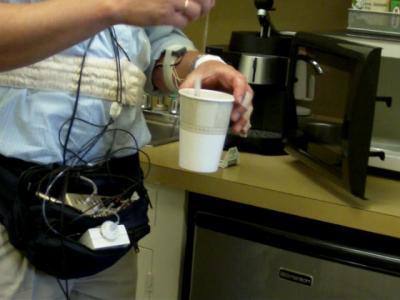Subtle physical changes impact panic sufferers more severely
People with panic disorder probably won't be surprised by the results, Meuret said.
By definition, the majority of the 13 symptoms of panic attack are physiological: shortness of breath, heart racing, dizziness, chest pain, sweating, hot flashes, trembling, choking, nausea and numbness. Only three are psychological: feeling of unreality, fear of losing control and fear of dying.
"Most patients obviously feel that there must be something going on physically," Meuret said. "They worry they're having a heart attack, suffocating or going to pass out. Our data doesn't indicate there's something inherently wrong with them physically, neither when they are at rest nor during panic. The fluctuations that we discovered are not extreme; they are subtle. But they seem to build up and may result in a notion that something catastrophic is going on."
Notably, the researchers found that patients' carbon dioxide, or C02, levels were in an abnormally low range, indicating the patients were chronically hyperventilating. These levels rose significantly shortly before panic onset and correlated with reports of anxiety, fear of dying and chest pain.
"It has been speculated, but never verified with data recordings in daily life, that increases in CO2 cause feelings of suffocation and can be panic triggers," Meuret said.
Fanny pack monitor tracked physiological changes before, during and after attacks
To capture the physiological data, 43 patients wore the monitoring devices for 24 hours on two separate occasions. The researchers collected 1,960 hours of ambulatory monitoring data, including 13 unexpected panic attacks.
Participants, all of whom suffer from panic disorder, were each outfitted with an array of electrodes and sensors attached to various parts of their bodies.
The ambulatory monitoring device was toted in a small waist pack the patients wore. Also included was a portable capnometer to measure CO2 collected from exhaled breath. The physiological responses were recorded continuously as digital data in a time series.
Each monitoring pack included a "panic button." Patients were instructed to press the button if they had an attack and to write down their symptoms. By triggering the panic button, patients inserted a marker into the time-series data, marking the moment the attack began.
The sensors measured eight physiological indices, including changes in respiration, such as how deep, fast or irregular people were breathing; cardiac activity; and evidence of sweating.
Data analysis found strikingly significant changes in the hour before attacks
From the nearly 2,000 hours of data, the change-point analysis program allowed the researchers to slice out 70-minute periods around each of the 13 panic attacks — from one hour before onset until 10 minutes after the attacks began.
For each index, the program checked for any significant change in the signal that remained stable over a specified period of time.
Those results were collapsed across all 13 panic attacks, with minute-by-minute averages. The information was then compared to a 70-minute control period randomly chosen during non-panic periods.
"We found 15 subtle but significant changes an hour before the onset of the panic attacks that followed a logical physiological pattern. These weren't present during the non-panic period," Meuret said.
"Why they occurred, we don't know. We also can't say necessarily they were causal for the panic attacks. But the changes were strikingly and significantly different to what was observed in the non-panic control period," she said.
Findings prompt look at "panic" definition and treatment
The study's results invite a reconsideration of the DSM diagnostic definition that separates "expected" from "unexpected" attacks, Meuret said.
Also, the study might explain why medication or interventions aimed at normalizing respiration for treating panic are effective, she said. Medication generally buffers arousal, keeping it low and regular, thereby preventing unexpected panic attacks.
For psychological treatments such as Cognitive Behavior Therapy (CBT), the results are more challenging. CBT requires a patient to focus on examining thoughts to prevent an attack.
"But a patient can't work on something they don't know is going to happen," Meuret said.
New methodology can be universalized to other unexpected medical problems
The study's use of change-point analysis can be applied to other medical issues. Traditional statistics are ineffective at analyzing such data, Meuret said, because they look only at level differences at pre-determined times and won't find a signal for an unknown point.
"This study is a step toward more understanding and hopefully opening more doors for research on medical events that are difficult to predict. The hope is that we can then translate these findings into new therapies," she said.

Panic attacks that seem to strike out-of-the-blue are not without warning after all, says psychologist Alicia Meuret, Southern Methodist University, Dallas.
A new study found significant physiological instability one hour before patients reported feeling a panic attack, Meuret says.
The findings suggest potentially new treatments for panic, and re-examination of other "unexpected" medical problems, including seizures, strokes and manic episodes.
(Photo Credit: SMU Research)

Ambulatory monitoring of panic attack sufferers (simulated in this image) found that panic attacks that seem to strike out-of-the-blue are not without warning after all, according to new research from Southern Methodist University.
(Photo Credit: Photo: SMU)
Source: Southern Methodist University